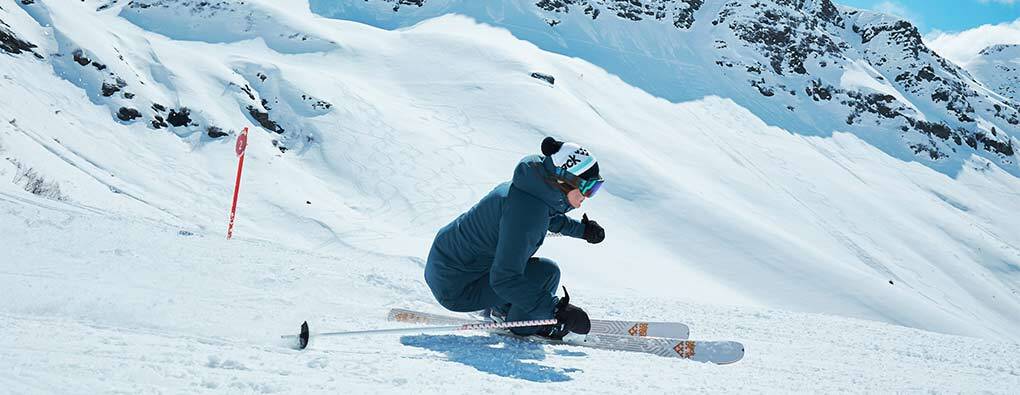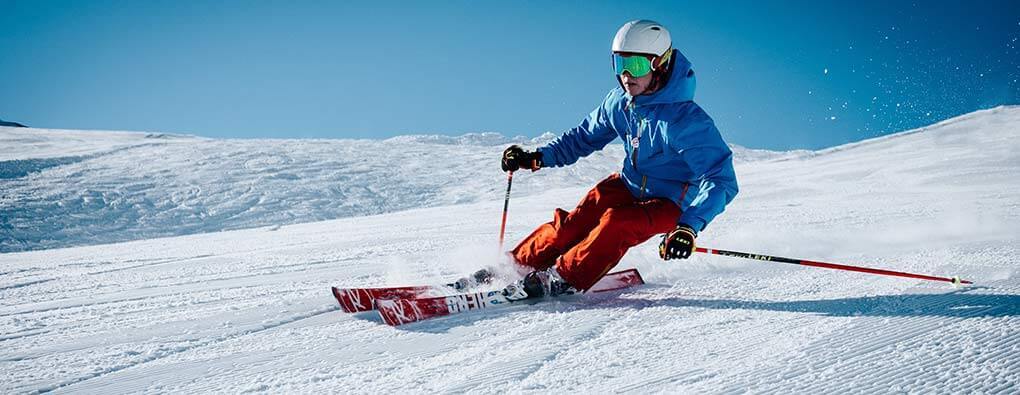Purchasing Skis for Novices
If you've recently taken up skiing and are considering buying your first set of skis, our guide will assist in steering you the right way. We simplify the process by helping you determine the ideal type of skis, the suitable length, and offer some details regarding ski width.
Prior to making a conclusive decision, it's crucial to look for skis meant for beginners. These skis are crafted to be more forgiving and easier to manage. They also come with bindings that can be adjusted to different sizes and are straightforward to use.
Owning your own skis means you can get used to their feel and how they respond to your movements, which is one significant benefit over renting.
PISTE SKIS - Optimal Carving Skis for Groomed Slopes
As indicated by the name, these skis are intended for use on-piste. Beginners devote their time on-piste to gain basic skills, making Piste skis an excellent option. Even after you progress on easy runs, Piste skis will support you in advancing further. Their usually narrow design enhances snow grip.
ALL MOUNTAIN SKIS - Premier All-purpose Skis

All Mountain skis demonstrate adaptability across various conditions. While they excel on the piste, they can also manage some off-piste skiing. If you've skied a few times and seek versatility beyond on-piste skiing, All Mountain skis could be ideal. These skis are crafted with a narrow to average width, offering a balance between gripping firm snow on-piste and handling softer, bumpier snow off-piste.
Browse for your All Mountain Skis
SPECIALISED SKIS
There are additional specialised skis such as Park, Racing, Freeride, and Touring skis, generally reserved for more skilled skiers. If this piques your interest, we suggest exploring our Purchasing Skis for Skilled Skiers to gain further insight.
Selecting the Correct Ski Length
To decide on the proper ski length, your height and skill level are essential. As a beginner, choosing a ski length nearing your nose is advisable. Each model is available in various lengths; therefore, select the one closest to your recommended length. (Being 3 cm longer or shorter shouldn't cause concern).
The size guide suggests that those with minimal skiing experience should opt for shorter skis due to their easier handling, important during the learning phase.
Your weight serves as a secondary consideration when selecting size. If your weight differs significantly from average, perhaps consider shorter skis for lighter individuals or longer skis for heavier ones.
The image depicts the ski length suitable for a novice skier
| All Mountain/Piste Skis | |
| Complete Beginner | Your height minus 20 cm |
| Novice | Your height minus 15 cm |
| Intermediate | Your height minus 10 cm |
| Proficient | Your height minus 5 cm |
| Expert | Your height |
Width of Skis
The skis' width indicates their performance on various terrains. Generally, narrower skis are suitable for hard snow, while wider skis suit soft snow. Ski width is noted in three figures, referring to tip - waist - tail dimensions.
The waist width is the most informative, always portrayed as the middle number. Example: 132/78/113
This measurement is shown on our site under each ski's specs.
Waist widths from 70 to 82mm are excellent for predominantly on-piste skiing, as they are designed to grip firm snow, making them the ideal selection for beginner skiers.
Additional Ski Gear
Ski Boots
Ski boots are perhaps the most crucial gear you should purchase for a skiing holiday. Our Ski Boot Buying Guide contains comprehensive information, but here are key points to start with.
Ski boot sizes are measured in centimetres, corresponding to the full length from heel to toe. Determine your precise size by measuring your feet with a tape or ruler. Each boot pair also has a flex rating, indicating shell flexibility. Beginners should find boots they can easily flex (Flex 60-90). Additional details and recommended boot flex can be found in our Boot Flex Guide.
Tip: Are your ski boots uncomfortable? Ensure your ski trousers are not tucked into your boots. Only your foot and tall ski sock should be inside. High-quality ski socks help avoid blisters, pain, or cold toes.
Ski Poles
Ski poles provide assistance on flat terrains and enhance balance. A round plastic disc is typically located at the pole’s lower end, preventing excessive sinking into the snow. The Ski Pole Length Chart will assist in selecting the correct pole length based on your height.
Helmets
Nowadays, nearly all skiers, novices or seasoned professionals, wear helmets—primarily for safety. Ski helmets are crafted to withstand multiple impacts, unlike skate or bike helmets, which aren't as robust.
Consider reading further about Proper Helmet Wear and Helmet Lifespan.
Goggles
Goggles greatly enhance skiing pleasure. They shield your eyes from harsh sunlight, strong winds, and snow, while also improving visibility. Learn more about goggles in our guide Complete Guide to Ski and Snowboard Goggles.



